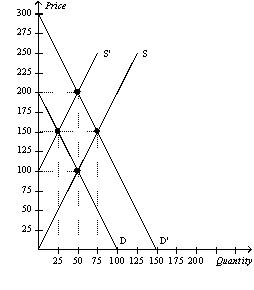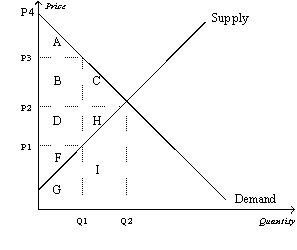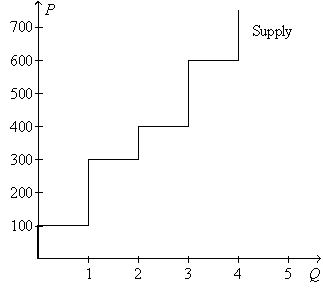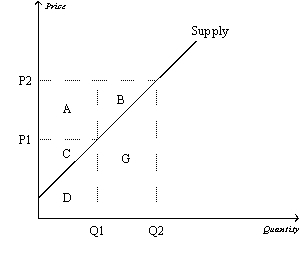A) increase.
B) decrease.
C) not change, since technology affects producers and not consumers.
D) not change, since consumers' willingness to pay is unaffected by the technological advance.
F) B) and C)
Correct Answer

verified
Correct Answer
verified
Multiple Choice
Figure 7-9  -Refer to Figure 7-9. If the supply curve is S', the demand curve is D, and the equilibrium price is $150, what is the producer surplus?
-Refer to Figure 7-9. If the supply curve is S', the demand curve is D, and the equilibrium price is $150, what is the producer surplus?
A) $625
B) $1,250
C) $2,500
D) $5,000
F) A) and B)
Correct Answer

verified
Correct Answer
verified
True/False
Market power and externalities are examples of market failures.
B) False
Correct Answer

verified
Correct Answer
verified
Multiple Choice
Producer surplus directly measures
A) the well-being of sellers.
B) production costs.
C) excess demand.
D) unsold inventories.
F) B) and C)
Correct Answer

verified
Correct Answer
verified
Multiple Choice
Total surplus in a market will increase when the government
A) imposes a tax on that market.
B) imposes a binding price floor on that market.
C) removes a binding price ceiling from that market.
D) None of the above is correct.
F) A) and C)
Correct Answer

verified
Correct Answer
verified
True/False
Welfare economics is the study of the welfare system.
B) False
Correct Answer

verified
Correct Answer
verified
Multiple Choice
Donald produces nails at a cost of $350 per ton. If he sells the nails for $500 per ton, his producer surplus is
A) $150.
B) $350.
C) $500.
D) $850.
F) B) and C)
Correct Answer

verified
Correct Answer
verified
Multiple Choice
The welfare of sellers is measured by
A) consumer surplus.
B) producer surplus.
C) total surplus.
D) price.
F) All of the above
Correct Answer

verified
Correct Answer
verified
Multiple Choice
Table 7-10 -Refer to Table 7-10. You and your best friend want to hire a professional photographer to take pictures of your two families. The table shows the costs of the four potential sellers in the local photography market. You and your friend agree to offer $500 for each session. Who accepts the offer, and what is the total producer surplus in the market?
A) LeBron and Kobe; $500
B) Kevin and Steve; $500
C) LeBron and Kobe; $300
D) Kevin and Steve; $150
F) C) and D)
Correct Answer

verified
Correct Answer
verified
Multiple Choice
Donald produces nails at a cost of $200 per ton. If he sells the nails for $350 per ton, his producer surplus per ton is
A) $150.
B) $200.
C) $350.
D) $550.
F) All of the above
Correct Answer

verified
Correct Answer
verified
Multiple Choice
A result of welfare economics is that the equilibrium price of a product is considered to be the best price because it
A) maximizes both the total revenue for firms and the quantity supplied of the product.
B) maximizes the combined welfare of buyers and sellers.
C) minimizes costs and maximizes output.
D) minimizes the level of welfare payments.
F) A) and C)
Correct Answer

verified
Correct Answer
verified
Multiple Choice
Table 7-5 For each of three potential buyers of oranges, the table displays the willingness to pay for the first three oranges of the day. Assume Alex, Barb, and Carlos are the only three buyers of oranges, and only three oranges can be supplied per day. -Refer to Table 7-5. Who experiences the largest loss of consumer surplus when the price of an orange increases from $0.70 to $1.40?
A) Allison
B) Bob
C) Charisse
D) All three individuals experience the same loss of consumer surplus.
F) All of the above
Correct Answer

verified
Correct Answer
verified
Multiple Choice
Figure 7-19  -Refer to Figure 7-19. At equilibrium, total surplus is represented by the area
-Refer to Figure 7-19. At equilibrium, total surplus is represented by the area
A) A+B+C.
B) A+B+D+F.
C) A+B+C+D+H+F.
D) A+B+C+D+H+F+G+I.
F) C) and D)
Correct Answer

verified
Correct Answer
verified
Multiple Choice
Table 7-7 The following table represents the costs of five possible sellers. -Refer to Table 7-7. If the market price is $900, the combined total cost of all participating sellers is
A) $3,700.
B) $2,700.
C) $2,250.
D) $1,250.
F) C) and D)
Correct Answer

verified
Correct Answer
verified
Multiple Choice
Figure 7-13  -Refer to Figure 7-13. If the price of the good is $300, then producer surplus amounts to
-Refer to Figure 7-13. If the price of the good is $300, then producer surplus amounts to
A) $100.
B) $200.
C) $300.
D) $400.
F) A) and B)
Correct Answer

verified
Correct Answer
verified
Multiple Choice
Figure 7-9  -Refer to Figure 7-9. If the supply curve is S, the demand curve is D, and the equilibrium price is $100, what is the producer surplus?
-Refer to Figure 7-9. If the supply curve is S, the demand curve is D, and the equilibrium price is $100, what is the producer surplus?
A) $625
B) $1,250
C) $2,500
D) $5,000
F) A) and C)
Correct Answer

verified
Correct Answer
verified
Multiple Choice
Table 7-11 -Refer to Table 7-11. Both the demand curve and the supply curve are straight lines. If the price is $4 but only 6 units are bought and sold, total surplus will be
A) $42.
B) $48.
C) $54.
D) $60.
F) All of the above
Correct Answer

verified
Correct Answer
verified
Multiple Choice
Figure 7-12  -Refer to Figure 7-12. Suppose producer surplus is larger than C but smaller than A+B+C. The price of the good must be
-Refer to Figure 7-12. Suppose producer surplus is larger than C but smaller than A+B+C. The price of the good must be
A) lower than P1.
B) P1.
C) between P1 and P2.
D) higher than P2.
F) C) and D)
Correct Answer

verified
Correct Answer
verified
Multiple Choice
One of the basic principles of economics is that markets are usually a good way to organize economic activity. This principle is explained by the study of
A) factor markets.
B) energy markets.
C) welfare economics.
D) labor economics.
F) A) and D)
Correct Answer

verified
Correct Answer
verified
Multiple Choice
Figure 7-19  -Refer to Figure 7-19. At equilibrium, consumer surplus is represented by the area
-Refer to Figure 7-19. At equilibrium, consumer surplus is represented by the area
A) A.
B) A+B+C.
C) D+H+F.
D) A+B+C+D+H+F.
F) A) and B)
Correct Answer

verified
Correct Answer
verified
Showing 261 - 280 of 460
Related Exams